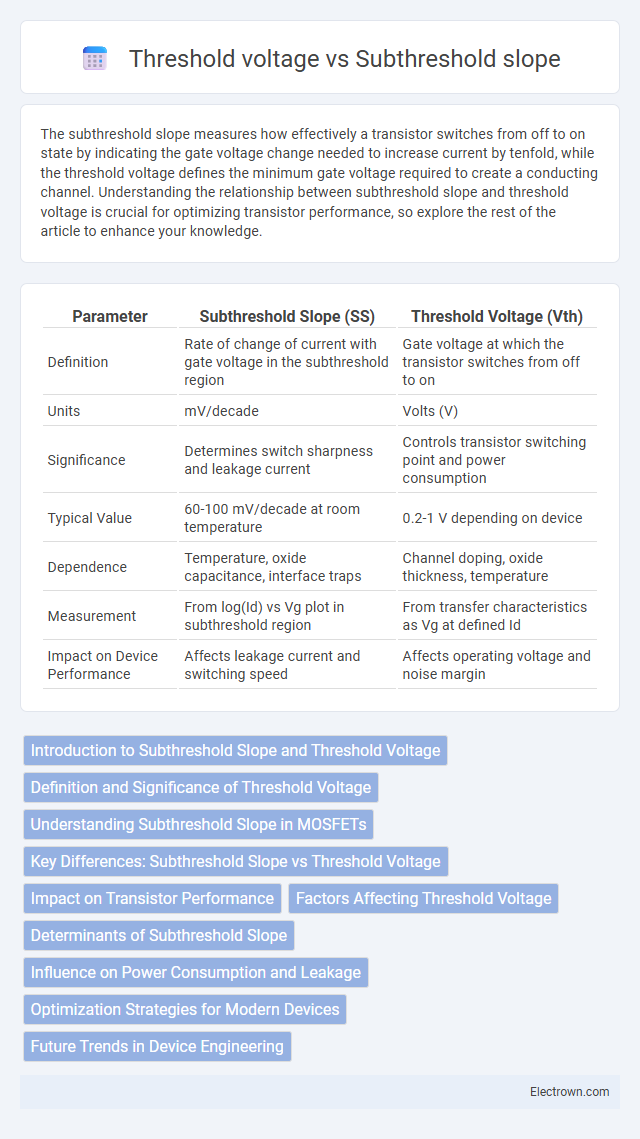The subthreshold slope measures how effectively a transistor switches from off to on state by indicating the gate voltage change needed to increase current by tenfold, while the threshold voltage defines the minimum gate voltage required to create a conducting channel. Understanding the relationship between subthreshold slope and threshold voltage is crucial for optimizing transistor performance, so explore the rest of the article to enhance your knowledge.
Table of Comparison
| Parameter | Subthreshold Slope (SS) | Threshold Voltage (Vth) |
|---|---|---|
| Definition | Rate of change of current with gate voltage in the subthreshold region | Gate voltage at which the transistor switches from off to on |
| Units | mV/decade | Volts (V) |
| Significance | Determines switch sharpness and leakage current | Controls transistor switching point and power consumption |
| Typical Value | 60-100 mV/decade at room temperature | 0.2-1 V depending on device |
| Dependence | Temperature, oxide capacitance, interface traps | Channel doping, oxide thickness, temperature |
| Measurement | From log(Id) vs Vg plot in subthreshold region | From transfer characteristics as Vg at defined Id |
| Impact on Device Performance | Affects leakage current and switching speed | Affects operating voltage and noise margin |
Introduction to Subthreshold Slope and Threshold Voltage
Subthreshold slope defines how effectively a transistor switches between off and on states by measuring the change in gate voltage needed to increase the drain current by one decade in the subthreshold region. Threshold voltage is the critical gate voltage at which a MOSFET channel forms and significant conduction begins, directly influencing device switching characteristics and power consumption. Understanding the relationship between subthreshold slope and threshold voltage is essential for optimizing your transistor's performance in low-power and high-speed applications.
Definition and Significance of Threshold Voltage
Threshold voltage is the minimum gate-to-source voltage required to create a conductive channel between the source and drain terminals in a MOSFET, marking the transition from the device's off-state to on-state. Its significance lies in determining the switching characteristics, power consumption, and noise margins of your transistor circuits, directly impacting device performance and energy efficiency. Understanding threshold voltage is critical for optimizing subthreshold slope, which measures how sharply the transistor switches on and affects leakage currents in low-power applications.
Understanding Subthreshold Slope in MOSFETs
Subthreshold slope in MOSFETs quantifies how effectively the device transitions from off to on state, measured as the voltage required to change the drain current by one decade in the subthreshold region. A steeper subthreshold slope indicates better switching characteristics and lower power consumption, critical for low-power electronics. Understanding this parameter helps you optimize threshold voltage and device performance in advanced semiconductor applications.
Key Differences: Subthreshold Slope vs Threshold Voltage
The subthreshold slope measures the efficiency of a MOSFET switching from off to on state, representing the voltage required to change the drain current by one decade in the subthreshold region. Threshold voltage defines the minimum gate voltage needed to create a conducting channel between source and drain in a transistor. Your device's switching speed and power consumption are significantly influenced by optimizing these parameters in semiconductor design.
Impact on Transistor Performance
Subthreshold slope directly affects the switching speed and power efficiency of a transistor by determining how sharply it transitions from off to on state. A lower subthreshold slope enables faster switching and reduces leakage current, improving your device's power consumption and overall performance. Threshold voltage influences the transistor's operating point and stability, with lower values enhancing drive current but potentially increasing leakage and variability.
Factors Affecting Threshold Voltage
Threshold voltage in MOSFETs is influenced by factors such as the doping concentration of the substrate, oxide thickness, and interface trap density, which alter the electric field and charge distribution at the semiconductor-oxide interface. Variations in threshold voltage directly impact the subthreshold slope by shifting the onset of strong inversion, thus affecting the device's switching efficiency and leakage current. Understanding these parameters helps you optimize transistor performance in low-power and high-speed applications.
Determinants of Subthreshold Slope
Subthreshold slope is primarily determined by the thermal voltage and the capacitance ratio between the depletion layer and the gate oxide in a MOSFET device. It quantifies how rapidly the transistor switches from off to on state, directly influencing the threshold voltage precision and overall device performance. To optimize your device's switching efficiency, controlling factors such as oxide thickness, doping concentration, and interface trap density is critical.
Influence on Power Consumption and Leakage
The subthreshold slope directly impacts leakage current by determining how sharply a transistor switches off beneath the threshold voltage, influencing your device's standby power consumption. A steeper subthreshold slope reduces leakage current, minimizing power waste when the transistor is off, while a lower threshold voltage enhances performance but increases leakage and power consumption. Optimizing both parameters is crucial for balancing energy efficiency and operational speed in low-power semiconductor devices.
Optimization Strategies for Modern Devices
Optimizing subthreshold slope and threshold voltage is critical for enhancing modern device performance, particularly in low-power applications. Techniques such as strain engineering, high-k dielectric integration, and advanced channel materials improve electrostatic control and reduce short-channel effects, enabling steeper subthreshold slopes and lower threshold voltages. Device architectures like FinFETs and gate-all-around nanowire transistors provide enhanced gate control, further optimizing these parameters for reduced leakage currents and improved switching speed.
Future Trends in Device Engineering
Future trends in device engineering emphasize reducing the subthreshold slope to near-ideal limits to enhance energy efficiency in low-power applications, with innovations such as steep-slope transistors including Tunnel FETs and negative capacitance FETs showing promise. Threshold voltage scaling continues alongside advanced materials like 2D semiconductors and high-k dielectrics to maintain control over leakage currents while enabling further miniaturization. These advancements aim to optimize the balance between subthreshold slope and threshold voltage for improved switching performance and reduced power consumption in next-generation integrated circuits.
Subthreshold slope vs threshold voltage Infographic

 electrown.com
electrown.com